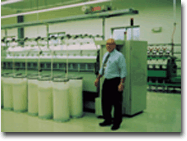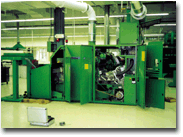 C
C
otton Incorporated has started the millennium on the right foot with the opening of its
new world headquarters in Cary, N.C. The newly built 125,053-square-foot facility will consolidate
the two research operations the company has in Raleigh, N.C. (Crabtree and Neil Street), along with
product marketing and integrated technical marketing. Approximately 110 of the company’s 160
employees will be in the Cary facility. Anything directed towards consumer trade, general promotion
and public relations will remain in New York City.
Construction of the new facility was funded by the Cotton Board, Memphis, Tenn. Estimated
costs are more than $10 million, which, according to Cotton Incorporated President and CEO J.
Berrye Worsham, was within the budget approved by the Cotton Board. Worsham said they have
estimated that by consolidating the Raleigh facilities and downsizing the New York City office,
they will save approximately $1 million annually in rent. Money that, according to Worsham, will go
back into the cotton program.
All Under One Roof
 The
The
plan to consolidate facilities in Cary got off the ground in 1996, when Hurricane Fran hit, causing
floods throughout the region. Cotton Incorporated’s Crabtree facility had two feet of water in it,
and the damage done totaled $750,000.
In December of 1996, the board asked Cotton Incorporated if they could move the Crabtree office.
The first thought was to expand the Neil Street facility, but it was soon decided that it would be
more cost-effective to build a new facility that would house both the Crabtree office and the Neil
Street facility. After numerous location scouts, an area was found that suited the company’s needs
in the Weston Office Park. Worsham said the search was concentrated in the Raleigh area.
“We like the area for a number of reasons,” he said. “For one, we have a good talent pool of
young people in the textile industry. You have the North Carolina State University School of
Textiles. You also have Duke and North Carolina nearby. So you have a good group of young people
interested in technology.
“Also you are close to the spinning activity in North Carolina, which is the largest area as
far as cotton spinning, and we’re within driving distance of the major textile mills. So this is a
good area between the talent pool and our customer base.”
Another advantage is that the new facility is near the Raleigh-Durham International Airport,
which makes customer travel to the facility much easier.
“It took about a year to develop plans and get the team together that was going to put
together the building; the builders, the architects and engineers,” Worsham said. “We really had to
do it right up front. We’re not like the sports complex down the road that started out as a
$40-million project and ended up as a $160-million project. We couldn’t have those kinds of
overruns. We had to get everything laid out just right in the beginning, to minimize change-overs
and lost time.” The company broke ground in October 1998 and moved into the completed facility in
December 1999. The official opening is set for April 18, 2000.
Research And Development
 Consolidating
Consolidating
facilities has brought the company closer together, making it more of a team-based environment.
With the old set-up, R&D personnel were driving back and forth between the two facilities. Now
they just have to walk down the hall.
The building was designed with workflow in mind. It is divided into two buildings connected
by a glass walkway. The front building is a two-story facility made up of offices that surround the
perimeter of the building. And even in the offices, cotton tests are being done — all of the
carpeting in the offices is cotton blended with nylon or polyester. The carpet in the executive
suite is cotton/wool. The carpet in the high-traffic areas, such as hallways and stairs, and in lab
buildings is commercial-grade nylon.
Through the glass walkway on the second floor is the testing facility. This was designed so
the cotton travels in a big circle. The warehouse is in the back corner, where the bales of cotton
are delivered. There is also a large warehouse area for storing fabric test rolls.
The cotton then travels to the Carding Lab. During
ATI’s visit, none of the machines in the lab were up and running yet. Some were
still in the process of being put back together from the move. Through a set of double doors is the
fully equipped Spinning Lab. Machines stood in the ready for the main switch to be thrown. Dr.
Preston Sasser, senior vice president, managing director, research, pointed out that each lab has
independent temperature and humidity controls. In the lab building, steam and hot water are used
for heat, while steam is used for humidity.
In the Knitting Lab, Sasser explained that each knitting machine was taken apart section by
section, brought to the new facility via truck, and put back together. The doors of the Knitting
Lab were specially designed to be tall enough to fit the knitting machines through them. The
hallways around the lab are wide enough to move machinery through.
The Applications Lab is the largest lab in the new facility. Its 24-foot-high ceiling is a
criss-cross of silver and white pipes and tubes.
Because it would not be cost-efficient to air condition such a large area that is
continuously running hot water and steam into machines, above each work station is a pipe that
dispenses cool air and mist onto the worker below.
All of the water used in the dyeing and other applications is drained from the machines into
trenches built into the floor. The waste water is stored outside of the facility. Sasser said
Cotton Incorporated discussed the disposal of the waste water with the town of Cary. The town has
enabled the company to release the waste water into the town sewage system at a rate of no faster
than 20 gallons per minute. A special meter keeps track of the water to make sure that it is being
released properly.
The chemical storage area is specially designed so if ever the sprinkler system comes on, the
water that comes down in that area stays in that area until the water can be tested before it is
pumped out.
The entire lab area is surrounded by research offices and smaller testing labs. There are
also several fabric libraries that store small swatches of every fabric the company has made, along
with every characteristic of that particular fabric. These libraries are identical in every office
of Cotton Incorporated.
A new development at the facility is a room that was made to be a life-sized light box.
Separate lighting systems representing natural, incandescent or fluorescent lighting can be used
individually or together to see the variations of dyed fabric.
Also, Cotton Incorporated is working with Raitech Inc., Charlotte, N.C., by using its
Quickwash™ line of testing instruments in the labs at the new facility. Sasser said that using the
Quickwash saves a lot of time and fabric because sample tests can be completed in minutes rather
than hours.
Meeting Customer Demands
 Customer
Customer
satisfaction is extremely important to Cotton Incorporated. Throughout the moving process, the
company was, for the most part, able to keep up with the needs of its customers.
“We continued to service the textile industry,” Worsham said. “One of our jobs in the textile
area is not just to do research, but to take presentations and information and visit textile
companies here in the United States and around the world.”
One thing did work in Cotton Incorporated’s favor in that most of the machinery was being
moved in November and December, when most of the mills are down for the holidays.
“We do still have the fabric development up and running,” Worsham said. “Some of our weaving
research is contracted out, so that is not affected. We can still visit mills and solve technical
problems over the phone, that hasn’t changed.
“This research center was developed to help further the interest of cotton. I think it will
be a benefit to the cotton producers. I think it will be a benefit to the cotton textile mills, as
well as the manufacturers and retailers that process cotton.”
April 2000




